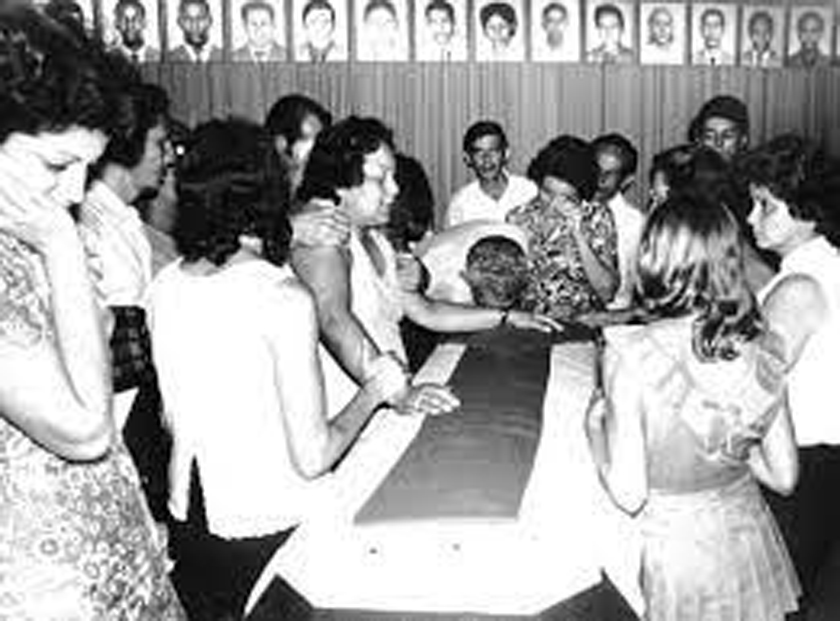
On October 6, 1976, a crime against mankind hit the people of Cuba hard: the bombing of a civil aeronautics plane in which 73 people were traveling, among them the victorious and youthful national fencing team that was returning home with all the prizes for its successful participation in the Central American and Caribbean Championship, held in Caracas, Venezuela.
There were no survivors of this monstrous act that had the decisive support of the Central Intelligence Agency (CIA), entrusted to the notorious hitmen and assassins Luis Posada Carriles and Orlando Bosch, who died years later without paying for this and other crimes, and made a reality by the executing hands of Venezuelans Freddy Lugo and Hernan Ricardo.
A small Korean delegation, a girl and 10 crew members, as well as 10 young Guyanese who came to study medicine on the island, were also passengers on the Cubana de Aviacion DC-8, flying flight CU-455.
The Commander in Chief Fidel Castro himself, in the act of farewell and mourning for the victims of the sabotage, held at the Revolution Square on October 15, with the attendance of a million Cubans, expressed that if before there were doubts about the involvement of the CIA, there was evidence, expressed in messages sent by that institution to a Cuban mercenary, suggesting that it was the very probable author of the plans of the terrible incident.
In those instructions, the Agency was very interested in knowing what measures would be taken in Cuba to avoid and prevent terrorist acts. The Leader wondered what interest the United States could have in the matter if it were not involved up to deep in the macabre affair.
Likewise, although the U.S. authorities pretended to be uncomfortable with the actions and the violent record of the henchmen of the Cuban counterrevolution based there, the truth is that they never ceased to give them devious orders, advice and abundant financial backing.
The brutal attack, after a stopover in Barbados, came to be the materialization of a series of attacks that the Cuban counterrevolution announced and even published in the press without any restraint, saying that they were planning to blow up an airplane of the Caribbean island in mid-flight. After the crime, both Orlando Bosch and Luis Posada Carriles notoriously and publicly boasted of their barbarities.
The perpetrators, Lugo and Ricardo, made part of the flight with the unfortunate passengers and were eyewitnesses to the joy of the team, brimming with life and promise. None of this stopped them, and without regrets of conscience these vermin placed the two planned explosive charges, of C-4, and calmly got off the aircraft during a stopover in Barbados.
The first failures and deadly explosions occurred a few minutes after leaving that country. Everything happened quickly, with no time to save the passengers and crew. And it is known that they tried to do so with great skill.
One always remembers a reflection by Fidel, in which he wondered what kind of horror or unspeakable feelings those human beings had suffered in those last minutes of their lives, without understanding anything, stuck in such a hell.
And it is a disturbing and humanist concern that is not forgotten.
Of course, Fidel was not wrong in his judgment about the CIA's responsibility. That was just one of several events perpetrated during that year, the format of which corresponded closely to the methods of the famous agency. They were aggressions and terrorist attacks against Cuba abroad, materially carried out by paid mercenaries.
Both the Federal Bureau of Investigation (FBI) and the CIA were especially present at meetings of the counterrevolutionary groups, both at home and abroad. This is how they learned of the intentions of these groups to blow up a Cuban airplane in mid-flight, months before the massacre perpetrated on the Barbadian stopover. And they took the lead in the matter.
Although they had been sent to meet in the Dominican Republic at the beginning of June 1976, nothing was alien to those institutions.
That is why, at the convenience of the U.S., for various rather tactical reasons and no moral ones, the Barbados crime plan was carried out by the counterrevolutionary organizations united outside the territory of the northern power.
New evidence of CIA involvement was uncovered four decades later, in June 2015, when documents declassified by the State Department corresponding to October and November 1976 were released.
In these, the then Secretary of State, Henry Kissinger, expressed his concern about the CIA's links with terrorist groups of Cuban origin, especially those related to the event off the coast of Barbados.
Cubans have never forgotten their brothers who died on that fateful day. Much less because from the beginning the imperial press wanted to play down the importance of the issue, trying to impose the version that it was an accident. A Cuban commission, in which the expert Julio Lara Alonso participated, proved to exhaustion with technical evidence that the plane fell into the sea due to the explosion of two bombs and the exact location of both devices was proved.
The terrible blow that that atrocity meant for the deceased, their families and relatives, was also joined by the great pain of the people as a whole, who lived days of mourning and homage, and of patriotic reaffirmation. Therefore, October 6 is also a day dedicated to the memory of the fallen victims of terrorism, an appointment that every year is a duty and a commitment that comes from the soul.
Sidebar

 Agencia Cubana de Noticias
Líder en información nacional
Agencia Cubana de Noticias
Líder en información nacional








Nos reservamos el derecho de no publicar los comentario que incumplan con las normas de este sitio